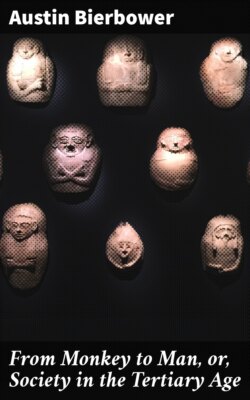Читать книгу From Monkey to Man, or, Society in the Tertiary Age - Austin Bierbower - Страница 10
На сайте Литреса книга снята с продажи.
CHAPTER VIII.
ОглавлениеTable of Contents
After the Snakes had been driven from the region of Cocoanut Hill, and the land thus rid of both wild beasts and reptiles, the Apes, who had now undisputed possession, got to fighting among themselves for the land. Those, therefore, who had united for defense now divided for conquest.
There were two principal varieties of Apes, as we have said,—the Ammi from whom the Men are descended, and the Lali, who, while resembling the former, were inferior in manners, and more closely resembled the present Orang-outang. They had both sprung from the same original stock, and, until several generations before, lived together in a more southerly country. At length they separated, (while still in the south), the Ammi going eastward, and the Lali westward, like the separation between Abraham and Lot.
Being thus separated, and so removed from mutual influence, they soon diverged in customs. The Ammi, under more favorable circumstances, began to walk erect, to live more on the ground, to find many uses for their hands, and to make some progress in speech. The Lali, who had wandered into a less hospitable country, made no progress whatever, but rather degenerated; so that when, generations later, the two varieties met again on Cocoanut Hill, there were marked differences between them.
They had both come to the Cocoanut Hill country in a great migration of monkeys from the South, the Ammi coming from the southeast and the Lali from the southwest. This migration was caused by the failure of fruits in the south on account of some cataclysm in Nature of which we have no reliable accounts; and monkeys of every kind came north, so that there were soon all the varieties of which we have spoken in the Cocoanut Hill region. And this failure of fruits, we may add, was a principal cause of the providence of the Monkeys in laying up stores; for they were anxious that a second famine should not occur like that in the land from which they had come.
These apes, having therefore met again, met with differences such as did not separate them in the south country; and, though they imitated one another to some extent (the Lali picking up some of the sounds of the Ammi, and so acquiring by degrees the habit of speaking, and also walking at times upright and using their hands), there were, nevertheless, irremovable differences between the two; and, though they made common cause as long as they had to fight tigers and snakes, they again asserted their differences with the return of peace, and so found it impossible to assimilate.
In view of this incongeniality the Ammi in time were found associating wholly among themselves, and the Lali likewise among themselves. Jealousies and suspicions arose between the two, and frequently fights. Class distinctions gave rise to class controversies, and finally to class wars. The Lali were soon hated as much as the snakes by the Ammi, who conceived the project of driving them from the country; and the Lali, in turn, resolved also to get the country for themselves.
After several conflicts, in which now one party and then the other was successful, and after several temporary compromises, in which they tried to live together, the Lali, partly vanquished and partly persuaded, consented to withdraw to the lands beyond the Swamp, leaving the Ammi in possession of the Cocoanut Hill region.
The separation, however, was no settlement. The Lali claimed the land which they did not take, and hoped to get in the future what they were willing to surrender for the present. The two parties stood, like Germany and France over Alsace and Lorraine, growling much, but doing little. Occasionally they made incursions into each other’s territory, and carried away some fruit or provisions; but, though they talked chiefly of war, they lived mainly in peace. Separated by snakes and swamps, they were kept at peace by the difficulty of coming together. The danger of crossing, and the delay in going around the Swamp, were too great for war.
This was the condition and situation of the two forces which occupied the world as known to our ancestors at the time of this story.
Having made this digression on the antiquities of the Apes and a bit of their history, in which we have seen the origin of their religion, government and industries, and of many of their customs, we shall now return to the scenes beginning this story, which are nearly a century later.
